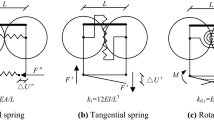Abstract
Coupled FEM–DEM simulations enable the direct analysis of the load, the deformation and the stresses inside machine parts which interact with bulk materials. The analysis of large deformations of elastic parts is interesting as the deformation will significantly influence the bulk material behaviour. In this paper a bidirectional coupling method for the FEM software \(\hbox {ANSYS}^\circledR \) Classic and the DEM software \(\hbox {LIGGGHTS}^\circledR \) is presented. The coupling algorithm was verified and validated using a modified draw down test rig. The results from the experimental investigations and the FEM–DEM simulations are compared. A very good correlation between experiments and simulations could be found.













Similar content being viewed by others
Abbreviations
- A :
-
Area, \(\hbox {mm}^{2}\)
- \(b_{\mathrm{out}}\) :
-
Width of the outlet, mm
- \(d_{\mathrm{k}}\) :
-
Grain size distribution, mm
- \(D_{\mathrm{part}}\) :
-
Particle distribution, mm
- E :
-
Young modulus of the steel sheet samples, \(\hbox {N/mm}^{2}\)
- \(E_{\mathrm{part}}\) :
-
Particle young modulus, \(\hbox {N/mm}^{2}\)
- \(\mathbf{f }\) :
-
Element force vector
- \(\mathbf{f}_{\mathrm{p} }\) :
-
Volume load vector
- \(h_{\mathrm{max}}\) :
-
Transfer height, mm
- \(I_{\mathrm{m}}\) :
-
Mass flow rate, t/h
- K :
-
Element stiffness matrix
- \({L}_{\mathrm{ELEM}}\) :
-
Finite element edge length, mm
- \(l_{\mathrm{LMP}}\) :
-
Measurement positions, mm
- \(l_{\mathrm{out}}\) :
-
Length of the outlet, mm
- \(m_{\mathrm{total}}\) :
-
Bulk material total mass, kg
- \(\mathbf{p}_{\mathrm{\mathbf{k}}}\) :
-
Vector for the element node loads
- p :
-
Pressure, N/mm\(^{2}\)
- t :
-
Time, s
- \(t_{\mathrm{elem }}\) :
-
Element thickness, mm
- \(t_{\mathrm{KL}}\) :
-
Flap opening time, s
- \(t_{\mathrm{sample}}\) :
-
Thickness of the steel sheet samples, mm
- \(t_{\mathrm{sim}}\) :
-
Simulation time, s
- v :
-
displacement vector
- v :
-
Poisson ratio, -
- \(v_{\mathrm{c}}\) :
-
Contact velocity, m/s
- \(v_{\mathrm{exp}}\) :
-
Maximum deformation during the experimental test, mm
- \(v_{\mathrm{sim}}\) :
-
Maximum deformation during the analogues FEM–DEM simulation, mm
- \(\Delta t_{\mathrm{DEM}}\) :
-
DEM timestep, s
- \(\Delta t_{\mathrm{FEM}}\) :
-
FEM timestep, s
- \(\Delta v\) :
-
Average of deformation, mm
- \(\varepsilon \) :
-
Porosity, -
- \(\mu _{\mathrm{P}}\) :
-
Coulomb friction coefficient, -
- \(\mu _{\mathrm{R}}\) :
-
Rolling friction coefficient, -
- \(\mu _{\mathrm{w, perspex}}\) :
-
Wall friction coefficient between bulk material and Perspex, -
- \(\mu _{\mathrm{w, sample}}\) :
-
Wall friction coefficient between bulk material and steel sheet, -
- \(\rho \) :
-
Material density of the steel sheet beams, \(\hbox {kg/m}^{3}\)
- \(\rho _{\mathrm{b}}\) :
-
Bulk material density, \(\hbox {kg/m}^{3}\)
- \(\varphi _{\mathrm{b,stat}}\) :
-
Angle of repose, \({^{\circ }}\)
References
Katterfeld, A., Dratt, M., Wheeler, C.A.: Coupling ANSYS and PFC\(^{3D}\) for the simulation of the conveyor belt deflection. In: Continuum and Distinct Element Numerical Modeling in Geomechanics, Proceedings of the 2nd International FLAC/DEM Symposium. Itasca Consulting Group, Melbourne (2011)
Dratt, M., Katterfeld, A., Wheeler, C.A.: Determination of the bulk flexure resistance via coupled FEM–DEM simulation. In: Bulk Solids Handling, no. 3, pp. 50–58. WoMa Media, Clausthal-Zellerfeld (2015)
Munjiza, A.: The Combined Finite-Discrete Element Method, 1st edn. Wiley, Chichester (2004)
Labra, C., Rojek, J., Oñate, E.: Adaptive discrete/finite element coupling for rock cutting process simulations. In: Munjiza, A. (ed.) Discrete Element Methods. Simulations of Discontinua: Theory and Applications, pp. 428–433. Queen Mary University, London (2010)
Rojek, J., Oñate, E.: Multiscale analysis using a coupled discrete/finite element model. Interact. Multiscale Mech. 1(1), 1–31 (2007)
Lu, X., Lin, X., Ye, L.: Simulation of structural collapse with coupled finite element-discrete element method. In: Yuan, Y., Cui, J., Mang, H. A. (eds.) Computational Structural Engineering, pp. 127–135. Springer, Shanghai (2009)
Villard, P., Chevalier, B., Le Hello, B., Combe, G.: Coupling between finite and discrete element methods for modeling of earth structures reinforced by geosynthetic. Comput. Geotech. Elsevier 36, 709–717 (2009)
Wellmann, C., Wriggers, P.: A coupled 3D discrete-finite element method for the simulation of granular materials and their interaction with solid structures. In: Proceedings in Applied Mathematics and Mechanics (PAMM), vol. 8, pp. 10353–10354. Wiley, Weinheim (2008)
Wellmann, C., Lillie, C., Wriggers, P.: A coupled discrete-finite element method modeling the interactions of granular materials and solid structures. In: 8th Word Congress on Computational Mechanics (WCCM8), 5th European Congress on Computational Methods in Applied Science and Engineering (ECCOMAS 2008), Venice (2008)
Stránský, J., Jirásek, M.: Open source FEM–DEM coupling. In: 18th International Conference Engineering Mechanics, pp. 1237–1251, Svratka (2012)
Michael, M., Vogel, F., Peters, B.: XDEM–FEM coupling of the intersections between a tire tread and granular terrain. Comput. Methods Appl. Mech. Eng. Elsevier 289, 227–248 (2015)
Müller, G., Groth, C.: FEM für Praktiker Band 1: Grundlagen, 8th edn. Expert Verlag, Renningen (2007)
Klein, B.: Grundlagen und Anwendungen der Finite Elemente Methode im Maschinen- und Fahrzeugbau, 7th edn. Vieweg Verlag, Wiesbaden (2007)
Betten, Josef: Finite Elemente für Ingenieure 1&2. Springer, Heidelberg (1997)
Dratt, M., Katterfeld, A., Wheeler, C.A.: Prediction of belt deflection by coupling of FEM and DEM simulations. In: Bulk Solids Handling, vol. 30, no. 7, pp. 380–384. Vogel Business Media, Würzburg (2010)
Bathe, K.-J.: Finite-Elemente-Methoden, 2nd edn. Springer, Berlin (2009)
Dratt, M.: Kopplung von FEM- und DEM-Simulationen zur Analyse der Gut-Bauteil-Interaktion in der Fördertechnik. Otto-von-Guericke-Universität Magdeburg, PhD Thesis (2016)
Wensrich, C.M., Katterfeld, A.: Rolling friction as a technique for modelling particle shape in DEM. Powder Technol. 217, 409–417 (2012)
Acknowledgements
The authors thank the German Ministry of Research and Education for the financial support of the research project “SimBa” (01 IS 13 006 A).
Author information
Authors and Affiliations
Corresponding author
Additional information
This article is part of the Topical Collection on: Understanding granular media - from fundamentals and simulations to industrial application.
Rights and permissions
About this article
Cite this article
Dratt, M., Katterfeld, A. Coupling of FEM and DEM simulations to consider dynamic deformations under particle load. Granular Matter 19, 49 (2017). https://doi.org/10.1007/s10035-017-0728-3
Received:
Published:
DOI: https://doi.org/10.1007/s10035-017-0728-3




